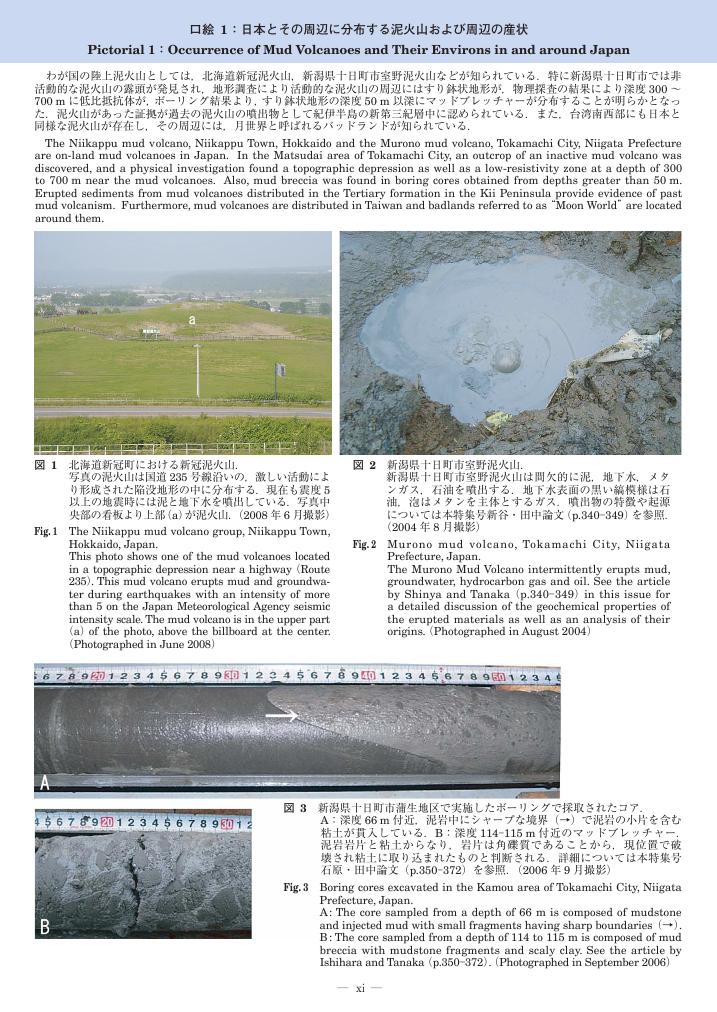- 著者
- 中田 英二 千木良 雅弘
- 出版者
- 公益社団法人 東京地学協会
- 雑誌
- 地学雑誌 (ISSN:0022135X)
- 巻号頁・発行日
- vol.118, no.3, pp.511-532, 2009-06-25 (Released:2010-03-26)
- 参考文献数
- 40
- 被引用文献数
- 10 9
Understanding erosion processes is important to prevent natural disasters such as slope failure and bedrock erosion in immature sedimentary rocks. Pliocene–Pleistocene illite-rich, non-smectite mudstone of the Gutingkeng Formation is distributed over 250 km2 in southern Taiwan, forming badlands (locally called moon-world) with mud volcanoes nearby. These volcanoes erupt saline water and natural gas, and producing a Na+, Ca2+, Cl-, and SO42- rich unsaturated Popcorn crust, which covers the mudstone slope surfaces in the moon-world area. In the crust porewater, ion strength reaches about 10 mol/L; zeta potential on particle surfaces shows a highly positive voltage. Repulsion occurs between particles under this high voltage in the crust, which is rapidly slaked to form mud by heavy precipitation. The zone that is rapidly slaked by precipitation reaches 10-20 cm beneath the crust surface. Ion strength of porewater of fresh mudstone is 0.5 mol/L approaches 0 mV (range 0.2-0.5 mol/L, pH 4-6). The surface charge of particles decreases with the infiltration of precipitation into the crust and fresh rock, with a minus surface charge occurring with increased rain infiltration. This leads to many cracks forming on the surface of mudstone, which is different from the mechanism of rapid slaking. Evaporation from the 10-20 cm-thick zone between the crust and the underlying fresh mudstone would stop if water was not supplied from depth, which is supported by in-situ measurements of water evaporation in the field. These mudstones erode readily under high precipitation because of the repulsion caused by the high ion strength of porewater. High-salinity porewater including mudstone is distributed near the active mud volcanoes where saline water rises and there is a rapid uplift rate. Rapid slaking occurred with some elements in the concentrated crust and near the surface drying zone.
1 0 0 0 OA 海底下堆積岩の浸水崩壊特性と水質が強度・透水特性に与える影響
- 著者
- 中田 英二 大山 隆弘 馬原 保典 市原 義久 松本 裕之
- 出版者
- Japan Society of Engineering Geology
- 雑誌
- 応用地質 (ISSN:02867737)
- 巻号頁・発行日
- vol.45, no.2, pp.71-82, 2004-06-10 (Released:2010-02-23)
- 参考文献数
- 29
- 被引用文献数
- 9 13
海底下に掘削された岩盤坑道において, 堆積岩試料を採取しその浸水崩壊特性について調査を行った. この結果, 海底下坑道で採取した堆積岩 (粗粒砂岩, 細粒砂岩, 砂質泥岩) は, 一度乾燥させたのち, 蒸留水に浸水させた場合, 崩壊して砂, 泥状になるものが多いことが明らかになった. 一方, 同じく乾燥させた試料を塩水に浸水させた場合, 崩壊しないことが明らかとなった. また採取した試料のうち, 方解石を含有する岩石は蒸留水中でも浸水崩壊しなかった. 海底下のようにNaイオンに富み, スメクタイト含有率が1.5wt%以上の岩石は浸水崩壊しやすく, 透水係数は粘性係数の大きな塩水を通水した方が, 蒸留水を通水した場合よりも大きくなる傾向が認められた. 蒸留水による透水試験終了後, CaCl2溶液を通水させた試料は, 浸水崩壊を起こさなかったことから, 岩石の力学的性質は間隙水に溶存するイオンの種類や濃度, 粘土鉱物の量と層間イオンの種類により異なると考えられた. 地下深部の利用に際しては水質が力学的性質へ与える影響も考慮しておくことが重要と思われた.
